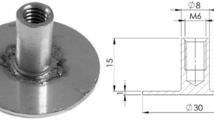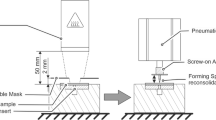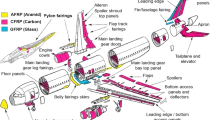Abstract
Modern lightweight constructions are increasingly based on the use of multi-material design such as fibre-reinforced plastics (FRP) combined with metallic material. The technology of screwing is rated, especially for applications where high-strength and permanent joints are required, among the established joining methods. To achieve a high-quality lightweight design, often, profile-intensive constructions are used, with the effect of one-sided accessibility to the joining area. Against this background, flow drill screwing offers an innovative solution for car body construction as well as the assembly for joining this combination of material. Currently, flow drill screwing with a pilot hole in FRP materials is used in the assembly process. To use this technology without a pilot hole and use it economically in the body framework, the auxiliary joining elements have to be optimised. This publication includes the latest research findings in the context of the development and qualification of joining by using flow drilling screws. It focuses on the specific adaptation of the auxiliary joining element with regard to the geometry, the material and the coating systems. With macroscopic and microscopic sections, as well as studies of strength, ultrasound and corrosion, it is possible to assess the quality of new and original FDS joints.













Similar content being viewed by others
References
Verordnung(EG) Nr. 443/2009 des europäischen Parlaments und des Rates vom 23. April 2009 zur Festsetzung von Emissionsnormen für neue Personenkraftwagen im Rahmen des Gesamtkonzepts der Gemeinschaft zur Verringerung der CO2-Emissionen von Personenkraftwagen und leichten Nutzfahrzeugen. Amtsblatt der Europäischen Union, 2009
Flegel H, Debschütz K-D Brüssel A Mischbauweise im Karosseriebau, Tagungsband DVS-Tagung „Dünnblechverarbeitung, Mischverbindungen – Innovative Lösungen für Leichtbaukonzepte“, München 10./141.04.2002. 153–164
Friedrich H (2003) Fahrzeugkonzepte und Bauweisen – Herausforderungen im 21. Jahrhundert. Symposieum: Paradigmenwechsel bei eForschung und Entwicklung, Bingen/Rhein
Wagner J, Lehminger F Challenges of mechanical joined CFRP-Mixed-Material-Structures in the process chain painted body; Joining in Car Body Engineering; Bad Nauheim; 24.03–25.03.2015
Bangel M, Rothe K, Sinzel S, Tassone R Development of mechanical joining technologies for mixed-material concepts involving CFRP in volume series production; Joining in Car Body Engineering; Bad Nauheim; 19.05–21.03.2016
Meschut G, Augenthaler F (2015) Hybridfügen von Mischbaustrukturen aus faserverstärkten Kunststoffen mit metallischen Halbzeugen. Öffentlicher Abschlussbericht zum gleichnamigen Forschungsvorhaben (DVS-Nr.: 08.080; IGF-Nr.: 17618 N), Deutscher Verband für Schweißen und verwandte Verfahren e.V., Düsseldorf
Meschut GGude M, Geske V, Augenthaler F (2015) Bewertung der Schädigung beim Stanznieten von Faser-Verbund-Kunststoffen. Öffentlicher Abschlussbericht zum gleichnamigen Forschungsvorhaben (EFB-Nr.: 02/112; IGF-Nr.: 17667 BG/1), Europäische Forschungsgesellschaft für Blechverarbeitung e. V., Hannover
Meschut G, Sartisson V (2015) Fügen von Mischbaustrukturen aus metallischen Werkstoffen und FKV-Bauteilen mittels Schließelement-Stanznieten. Öffentlicher Abschlussbericht zum gleichnamigen Forschungsvorhaben (EFB-Nr.: 04/112; IGF-Nr.: 17597 N), Europäische Forschungsgesellschaft für Blechverarbeitung e. V., Hannover
Wilhelm M, Füssel U, Nancke T, Duschl M (2013) Herausforderung CFK-Stahl-Mischbau: Quantifizierung von Delaminationen infolge des umformtechnischen Fügens. DGZfP-Jahrestagung 2013, Dresden
Wagner J, Wilhelm M, Baier H, Fuessel U, Richter T (2014) Experimental analysis of damage propagation in riveted CFRP-steel structures by thermal loads. Int J Adv Manuf Technol:1103–1113. doi:10.1007/s00170-014-6197-5
Wilhelm MF, Fuessel U, Richter T, Riemer M, Foerster M (2015) Analysis of the shear-out failure mode for cfrp joints joined by forming. J Compos Mater 49(8):981–993. doi:10.1177/0021998314528264
Stamm K Risiken beim Einsatz von neuen Werkstoffen im Leichtbau (CFK / Verbundwerkstoffe); 5. Fachtagung Innovative Verbindungstechnik Schrauben, Sindelfingen, 27.-28.10.2015
Küting J (2004) Entwicklung des Fließformschraubens ohne Vorlochen für Leichtbauwerkstoffe im Fahrzeugbau. Dissertation, Universität Paderborn
Bye C (2006) Erweiterung des Einsatzfeldes von loch- und gewindeformenden Dünnblechschrauben zum Verbinden von Aluminiumhalbzeugen. Dissertation, Universität Paderborn
Birkelbach R, Wildi H (1988) Aus drei Operationen wird eine. Neue Verbindungstechnik für Dünnbleche; in SMM Heft 27
Großberndt H (1992) Lösbares Verbindungselement für Dünnbleche: Die FlowDrill-Schraube; Blech Rohre Profile 39 Heft 10
Kretschmer G (1991) Fließlochformen und Gewindefurchen - mit einem Werkzeug, dem Verbindungselement selbst. Werkstatttechnik 81:633–636
Skovron J, Mears L, Ulutan D, Detwiller D, Paolini D, Baeumler B, Claus L (2015) Characterization of Flow Drill Screwdriving Process Paramters on Joint Quality. SAE Int J Mater Manf 8(1):35–44. doi:10.4271/2014-01-2241
N.N.: Produktbeschreibung TEPEX® dynalite 101 und 201 PA66, Bond-Laminates GmbH, 2015
Meschut G, Nagel P Abschlussbericht zum öffentlichen Forschungsprojekt: „Einsatz des Direktverschraubens zum Verbinden faserverstärkter Kunststoffe mit metallischen Werkstoffen ohne Vorloch“ (IGF-Nr.: 17595 N/1 / EFB Nr.: 01/112)
Author information
Authors and Affiliations
Corresponding author
Additional information
Recommended for publication by Select Committee AUTO - Automotive and Road Transport
The IGF-project IGF-Nr.: 17595 N/1 (EFB Nr.: 01/112) of the Europäischen Forschungsgesellschaft für Blechverarbeitung e. V. was promoted through the AiF under the program for the promotion of joint industrial research and development (IGF) by the Federal Ministry of Economics and Energy due to a resolution of the German Bundestag.
Rights and permissions
About this article
Cite this article
Nagel, P., Meschut, G. Flow drill screwing of fibre-reinforced plastic-metal composites without a pilot hole. Weld World 61, 1057–1067 (2017). https://doi.org/10.1007/s40194-017-0493-2
Received:
Accepted:
Published:
Issue Date:
DOI: https://doi.org/10.1007/s40194-017-0493-2




